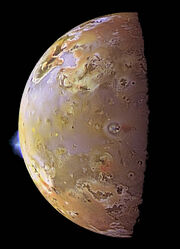| Io | |
|---|---|
 | |
| Description | |
| Satellite of | Jupiter |
| Orbital period | 42 hours |
| Diameter: | 3,643 km |
| Radius: | 1,822 km |
| Discovered | January 8, 1610 |
| Discoverer(s) | Galileo Galilei |
Io is the innermost of the four Galilean moons of the planet Jupiter. It is the fourth-largest moon, has the highest density of all the moons, and has the least amount of water of any known astronomical object in the Solar System.
Surface[]
A bit larger than Earth's moon, Io is the innermost of Jupiter's large satellites and the most volcanically active body in the solar system, with plumes of matter rising up to 186 miles (300 km) above the surface.
Volcanic Features[]

A lava on Io's surface.

Color mosaic and active volcanic plumes on Io.
Jupiter's strange moon is literally bursting with volcanoes. Dozens of active vents pepper the landscape with volcanic rings the size of California. The volcanoes themselves are the hottest spots in the solar system with temperatures exceeding 1800 K (1527 C) about 1/3 the temperature of the surface of the Sun. The plumes which rise as much as 500 kilometers into space. Confounding common sense, these high-rising ejecta seem to be made up of, not blisteringly hot lava, but frozen sulfur dioxide. For a world dominated by fiery volcanoes, it's curious that Io is also very, very cold. The ground just around the volcanic vents is literally sizzling, but most of Io's surface is 150 degrees or more below 0 C.
Exploration[]
Jupiter's third-largest moon began with its discovery in 1610 and continues today with Earth-based observations and visits by spacecraft to the Jupiter system.
Pioneer[]
The flybys of the two Pioneer probes, Pioneer 10 and 11 in 1973 and 1974, provided the first accurate measurement of Io's mass and size. Data from the Pioneers also revealed an intense belt of radiation near Io and suggested the presence of an atmosphere.
Voyager[]
In 1979, the two Voyager spacecraft flew through the Jupiter system. Voyager 1, during its encounter in March 1979, observed active volcanism on Io for the first time and mapped its surface in great detail, particularly the side that faces Jupiter. The Voyagers observed the Io plasma torus and Io's sulfur dioxide (SO2) atmosphere for the first time.
Galileo[]
NASA launched the Galileo spacecraft in 1989, which entered Jupiter's orbit in December 1995. Galileo allowed detailed study of both the planet and its satellites, including six flybys of Io between late 1999 and early 2002 that provided high-resolution images and spectra of Io's surface, confirming the presence of high-temperature silicate volcanism on Io. Distant observations by Galileo allowed planetary scientists to study changes on the surface that resulted from the moon's active volcanism.
Future missions[]
Following Galileo and a distant encounter by the Pluto-bound New Horizons spacecraft in 2007, NASA and the European Space Agency (ESA) made plans to return to the Jupiter system and Io. In 2009, NASA approved a plan to send an orbiter to Europa called the Jupiter Europa Orbiter as part of a joint program with ESA called the Europa/Jupiter System Mission. The ESA component of the project was the Jupiter Ganymede Orbiter. However, the EJSM mission collaboration was cancelled. ESA is continuing with its initiative under the name Jupiter Icy Moon Explorer (JUICE) to explore Ganymede, Europa, and Callisto, without plans to investigate Io at all. The proposed NASA Discovery mission Io Volcano Observer, currently going through a competitive process to be selected, would explore Io as its primary mission.
| Moons of Jupiter |
|---|
| Ganymede • Callisto • Io • Europa |